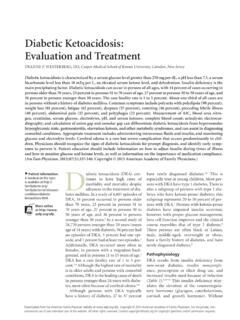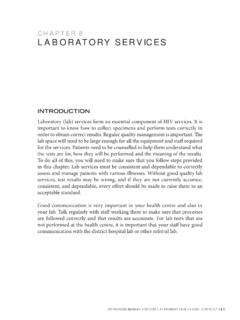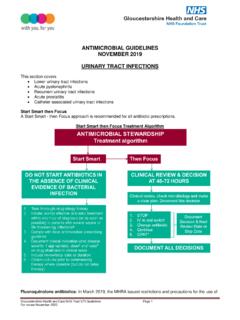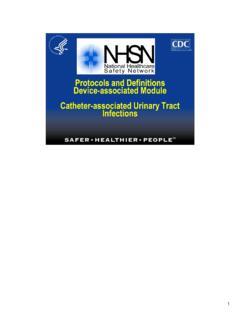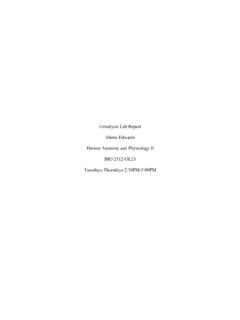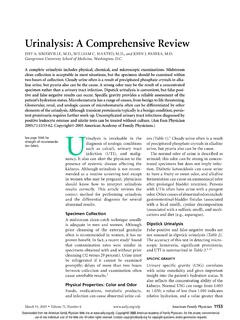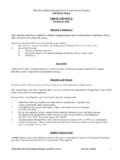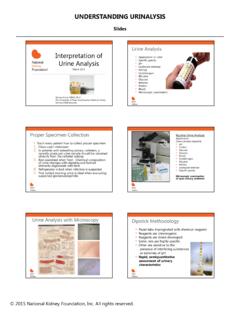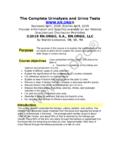Transcription of Continence Assessment Form and Care Plan
1 Assessment Cues (tick appropriate response) Care Options (tick appropriate care option)1. Does the resident know when to go to the toilet? Yes Sometimes NoIf sometimes or no: Identify behaviours showing that the resident may need to go to the toilet (eg restlessness) (List possible cues) _____ _____ Supervise Prompt Physically assist the resident to go to the toilet at fixed times individualised times2. Can the resident tell you where the toilet is? Yes Sometimes NoIf sometimes or no: Show/remind the resident where the toilet is Ensure toilet is easy to identify Leave the toilet light on 3. Can the resident walk to the toilet independently? Yes, independently Sometimes No, requires supervision No, requires physical assistance No, requires lifting equipment N/A, unable to use toiletIf sometimes or no: Place the resident close to the toilets Place the following ambulation aids close to the resident Wheely frame Pick up frame Gutter frame Walking stick Wheel chair Other _____ Supervise Prompt Physically assist the resident to walk to the toilet If physical assistance is required, provide: 1 staff member 2 staff members Lifting equipment Other _____4.
2 Can the resident get on and get off the toilet independently? Yes, independently Sometimes No, requires supervision No, requires physical assistance No, requires lifting equipment N/A, unable to use toiletIf sometimes or no: Encourage the resident to use the following assistive devices Handrails An over the toilet seat frame A donut Other _____ Supervise Prompt Physically assist the resident to get on and off toilet If physical assistance is required, provide: 1 staff member 2 staff members Lifting equipment Other _____5. Can the resident undress and dress themselves before and after toileting? Yes, independently Sometimes No, requires supervision No, requires physical assistance No, requires lifting equipment N/A, unable to use toiletIf sometimes or no: Ensure that the resident has clothing that is easy to manage ( elastic waisted pants with no zips).
3 Supervise Prompt Physically assist the resident to adjust their own to Education Guide for further information on Assessment cues and care options Continence Assessment form and Care PlanRESIDENT IDBest practice recommendations Encourage residents to participate as much as possible in toileting activities to remain optimal mobility and independence Consider each residents personal preferences for Continence care1 Date: _____/_____/_____SECTION A: Toileting ability, Cognitive skills & MobilityDeveloped by Deakin University and funded under the National Continence Management Strategy2 Assessment Cues (tick appropriate response) Care Options (tick appropriate care option)6. Can the resident use toilet paper and wipe themselves? Yes, independently Sometimes No, requires supervision No, requires physical assistanceIf sometimes or no: Supervise Prompt Physically assist the resident to get toilet paper ready and to use it.
4 Supervise Prompt Physically assist the resident to wash their hands at toilet Does the resident co-operate with staff when they assist with toileting or changing? Yes Sometimes NoIf sometimes or no: ask the RN, Continence Nurse or GP about the care required and refer to resident s behavioural management Does the resident experience pain that restricts their toileting ability? Yes Sometimes NoIf sometimes or yes: Check that the resident is getting their pain medication as ordered Limit the resident s movement until pain subsides Offer bedpans, urinals and/or pads If the resident is unable to verbally communicate, search for cues that indicate pain. (List possible cues) _____ _____Assessment Cues (tick appropriate response) Care Options (tick appropriate care option)9.
5 During the day, how many times does the resident need to pass urine/go to the toilet on average (from 7am-7pm)? Less than 3 times 4 - 6 times (normal) More than 6 times If less than 3 times, ask the RN, Continence Nurse or GP about the care required. If more than 6 times, ask the RN, Continence Nurse or GP about the care During the night, how many times does the resident need to pass urine/go to the toilet on average (from 7pm-7am)? None Once Two or more timesIf once or more: Ensure call bell is within reach. Turn night light on. Ensure commode/pan/toilet is near the bed. Turn sensor/s on. If resident is awake, offer toileting assistance. If the resident passes urine two or more times during the night, ask the RN, Continence Nurse or GP about the care practice recommendations Aim for the resident to be continent and to void 4-6 times a day and no more than 2 times at night Aim for the resident to have a regular (at least 3 per week) continent, soft formed stool ( Bristol Stool type 3 or 4 that is easy to pass) If the resident has incontinence, aim for them to feel clean and dry with changes of pads soon after each episode Assess residents risk for falling if they need to go to the toilet at nightSECTION B: Bladder & Bowel patternSECTION A.
6 Toileting ability, Cognitive skills & Mobility (continued)Refer to 3 day bladder chart and 7 day bowel chart to complete questionsDeveloped by Deakin University and funded under the National Continence Management StrategyAssessment Cues (tick appropriate response) Care Options (tick appropriate care option)11. Does the resident experience urine leakage during the day? Yes NoIf yes, how often? Once every few days Once a day Several times a day Most or every timeIf yes to urine leakage during the day: Develop and put in place an individualised toileting program Develop and put in place a fixed time toileting program Develop and put in place a pad check and change program12. Does the resident experience urine leakage during the night? Yes NoIf yes, how often? Once every few nights Once a night Several times a night Most or every timeIf yes to urine leakage during the night: Develop and put in place an individualised toileting program Develop and put in place a fixed time toileting program Develop and put in place a pad check and change program13.
7 Does the resident have a predictable pattern of passing urine (including urine leakage) ?a) During the day? Yes Nob) During the night? Yes NoIf yes: Refer to the 3 day bladder chart and use the grid below to mark the times for an individualised toileting program based on the resident s no: Use the grid below to mark the times for a fixed time toileting program ( at least every 4 - 6 hours during the day) Use the grid below to mark the times for a pad check and change program ( at least every 4 - 6 hours during the day) Assessment Cues (tick appropriate response) Care Options (tick appropriate care option)14. Does the need to pass urine or incontinence at night make it difficult for the resident to go back to sleep? N/A No Sometimes YesIf sometimes or yes: Place a commode beside the resident s bed.
8 Offer the resident a bedpan or urinal. Identify and put in place individualised strategies to help the resident to return to sleep3 SECTION B: Bladder & Bowel pattern (continued)Toileting / pad check and change grid (please tick)mid- night1 am2 am3 am4 am5 am6 am7 am8 am9 am10 am11 am12 noon1 pm2 pm3 pm4 pm5 pm6 pm7 pm8 pm9 pm10 pm11 pmToileting timesPad check & change timesDeveloped by Deakin University and funded under the National Continence Management Strategy4 Assessment Cues (tick appropriate response) Care Options (tick appropriate care option)15. Does the resident have a urinary catheter in place? Yes NoIf yes, is the catheter Suprapubic? Urethral? If yes, ask the RN, Continence Nurse or GP about the care required and refer to resident s catheter care plan. No assistance required to empty catheter bag Supervise the resident to empty catheter bag Physically assist the resident to empty catheter bag16.
9 How often does the resident normally use their bowels? Daily to second daily Less than 3 times per week If less than 3 times per week, or if yes to question 17: discuss the following options with RN, Continence Nurse or GP Increase fluid to _____ a day. Increase fibre by _____. Increase mobility (refer to mobility / activity care plan). Medication (as determined by RN, Continence Nurse or GP). Refer for further investigation ( Abdominal X-Ray, GUT motility study). Monitor bowel elimination frequency and stool consistency. Prompt / supervise / assist resident to the toilet at _____ each day. Encourage the resident to respond to the urge to use their bowels. Supervise / prompt / assist the resident to sit on the toilet and rest their elbows on their knees with their feet flat on the floor or stool to facilitate bowel In the past two weeks has the resident leaked, or had accidents or lost control with stool/bowel motion?
10 Yes No18. Has the resident got any of the following symptoms when they use their bowels? Pain and discomfort Straining Bleeding Hard, dry motions Very fluid bowel motions If yes to any symptom, ask the RN, Continence Nurse or GP about the care Has the resident had a urine test ( dipstick ) done in the past 28 days? Yes No (this needs to be done)pH _____ SG _____Blood Yes No Nitrites Yes No Leukocytes Yes No If the resident s urine dip- stick shows blood or nitrites or leukocytes or has a pH equal to 8 or above, ask the RN, Continence Nurse or GP about the care required. Further comments and/or observations _____SECTION B: Bladder & Bowel pattern (continued)Developed by Deakin University and funded under the National Continence Management Strategy5 Assessment Cues (tick appropriate response) Care Options (tick appropriate care option)20.
